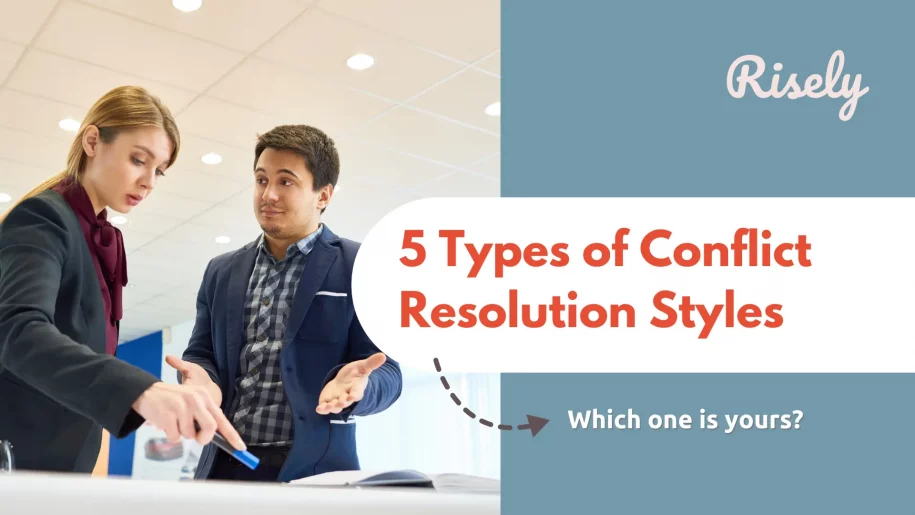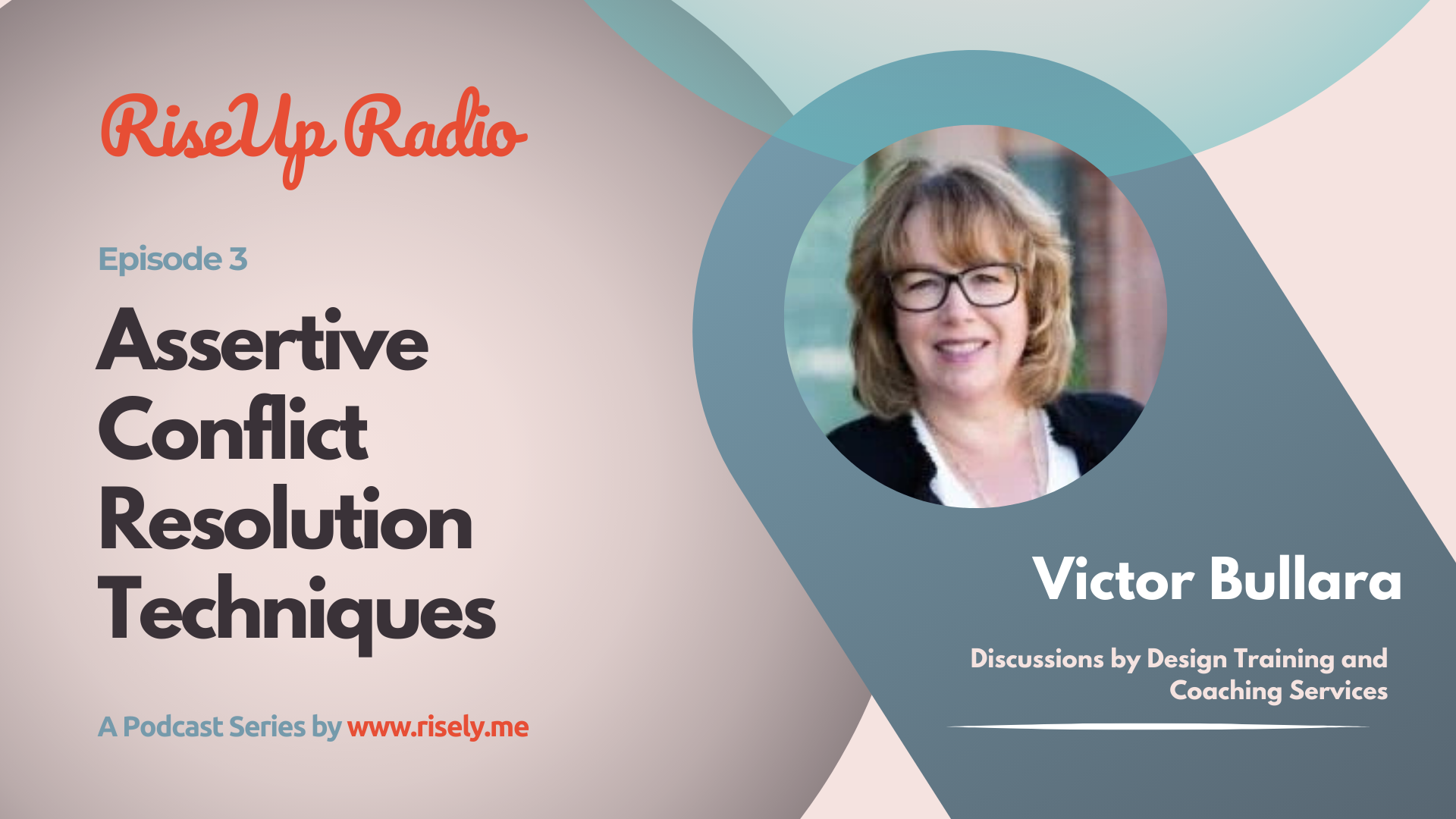5 Types of Conflict Resolution Styles: Which one is yours?
Conflict resolution is a skill that involves managing emotions, understanding different conflict styles, and navigating team dynamics. It’s about having the right mindset and abilities to recognize conflict situations and choose appropriate resolution methods. Unfortunately, conflict management often gets overlooked and carries negative associations in many organizations. In this blog, we’ll explore 5 common conflict resolution styles used in decision-making and group settings. You’ll learn how managers can apply these styles effectively and how to determine which style suits various conflicts or disagreements. Whether you’re a manager or simply interested in understanding conflict management better, this blog is for you. Keep reading to discover valuable insights!What is Conflict Resolution?
Conflict is a term used to describe disagreement between people or groups. It can range from minor disagreements to conflicts that can lead to wars. A conflict arises when two or more parties have competing interests and cannot reach a mutually satisfactory resolution. Conflict resolution is a process that helps resolve disagreements and disputes between two or more parties. The goal of conflict resolution is to find a mutually acceptable solution that addresses the concerns of all parties involved and restores or improves relationships. It is important to note that conflict resolution is not only about winning or being right, but also about finding a way to reach a mutually beneficial outcome.What is a Conflict Resolution Style?
Conflict resolution style refers to individuals’ different approaches and strategies to manage and resolve conflicts. These styles can vary depending on the individual’s personality, background, and previous experiences. Understanding different conflict resolution styles can help individuals to identify their preferred approach and to adapt their style to suit better the specific situation and parties involved in a conflict. Several commonly recognized conflict resolution styles exist with style having its strengths and weaknesses and may be more or less effective depending on the situation.The Conflict Resolution Styles Grid
The conflict resolution styles grid is a tool that can help managers identify the most appropriate approach to resolving a conflict. Kenneth Thomas and Ralph Kilmann developed this grid in the 1970s. They used two main dimensions in this grid which are assertiveness and cooperativeness. The assertiveness dimension measures how much a person tries to satisfy their concerns and interests. In contrast, the cooperativeness dimension measures how much a person is trying to meet the concerns and interests of others.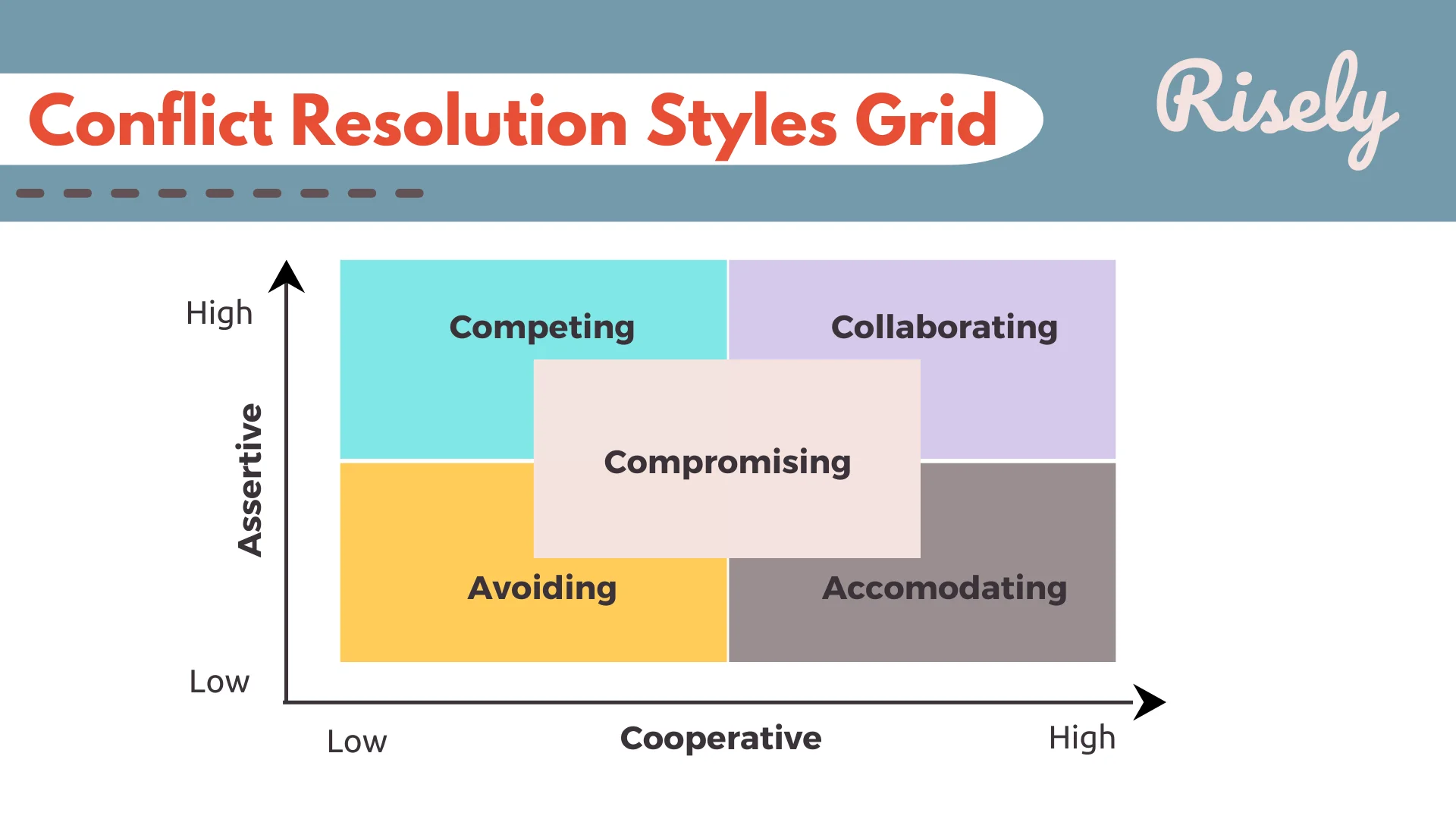
- Competing
- Accommodating
- Avoiding
- Collaborating
- Compromising
The 5 Types of Conflict Resolution Styles
Competing
The competing is a conflict resolution style, also known as the “forcing” style. It is characterized by a high level of assertiveness and a low level of cooperativeness. In this style, individuals prioritize their own goals and interests over those of others and are willing to use power or authority to achieve their objectives. For example, this conflict resolution style is often functional when people perceive limited resources and want to ensure they get their fair share. Example of the competing style of conflict resolution: A manager notices that two team members are constantly arguing about the direction of a project. The manager decides to make a final decision on the approach and informs both team members that they need to follow this direction without further debate. The manager believes that their decision is in the best interest of the project and the organization. Advantages of the competing style:- It can be effective when time is of the essence, and a quick resolution is needed.
- It can be effective in cases where the other party is unwilling to compromise or negotiate.
- It can be helpful when an individual or group is in a position of power and needs to assert its authority.
- It can be seen as aggressive and may create resentment or hostility from the other party.
- It may not lead to a mutually beneficial outcome and can result in a “winner” and “loser” mentality.
- It can damage relationships, and the other party may be less likely to work with the individual.
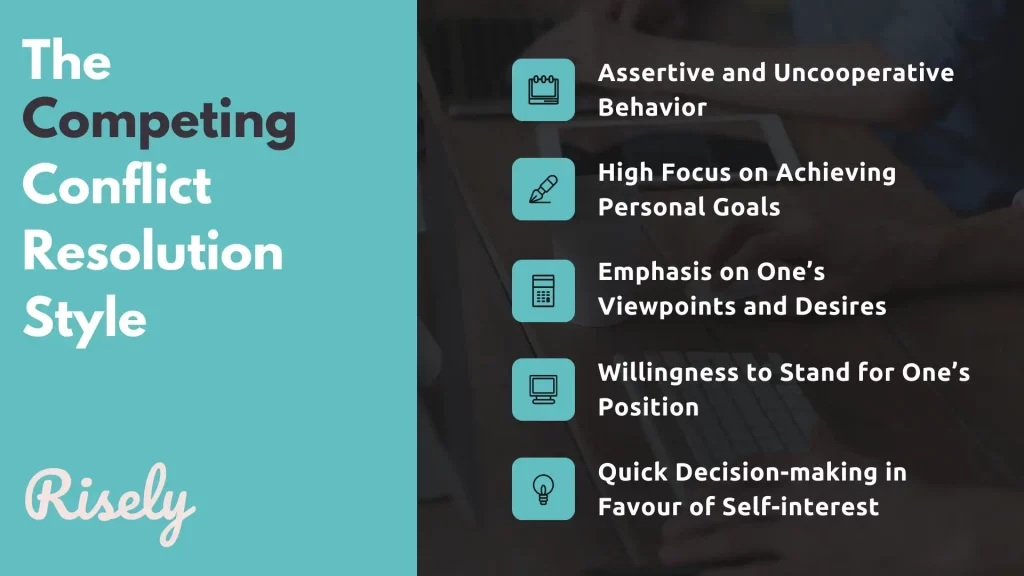
Accommodating
The accommodating conflict resolution style, also known as the “yielding” style, is characterized by a low level of assertiveness and a high level of cooperativeness. In this style, individuals prioritize the goals and interests of others over their own and are willing to compromise or make concessions to maintain harmony and avoid confrontation. This style is valid when a person perceives that the relationship with the other party is more important than the outcome of the conflict and wants to preserve the relationship. Example of the accommodating style of conflict resolution: In a situation where a team member is facing personal difficulties and requests some time off during a critical project phase, the manager decides to accommodate their request. The manager understands the team member’s challenges and agrees to temporarily reassign their tasks to other team members, ensuring the individual can manage their personal matters. Advantages of the accommodating style:- It can be effective in preserving relationships and maintaining harmony.
- It can help avoid the escalation of a conflict.
- It can be an excellent way to defuse a potentially volatile situation.
- It can be seen as weak and may lead to a partial resolution.
- It can result in the individual not getting their own needs met.
- It can be taken advantage of by the other party in future conflicts.
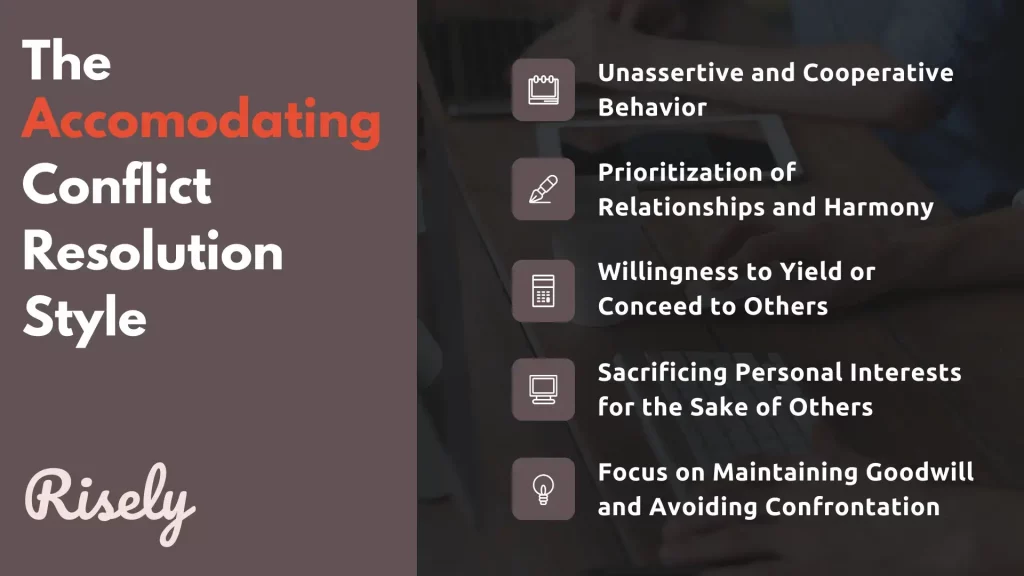
Avoiding
Also known as “withdrawing,” is the conflict resolution style with low assertiveness and cooperativeness. In this style, individuals avoid or postpone the conflict and do not express their own needs or concerns or attempt to address the needs or circumstances of others. This style is helpful when a person perceives that the conflict is too difficult to resolve or that the issue is not important enough to justify the effort. Example of the avoidance style of conflict management: A manager becomes aware of a minor disagreement between two team members but decides not to address it immediately, hoping that the issue might resolve itself over time. The manager focuses on other pressing matters, hoping that the conflict will fade away without their intervention. Advantages of the avoiding style:- It can be effective in preventing the escalation of a conflict.
- It can help preserve relationships by avoiding confrontation.
- It can be a good way to defuse a potentially volatile situation.
- It does not lead to resolving the conflict, and the underlying issues may resurface later.
- It might appear as a lack of leadership or willingness to address critical issues.
- It can lead to unresolved issues festering and causing problems in the future.
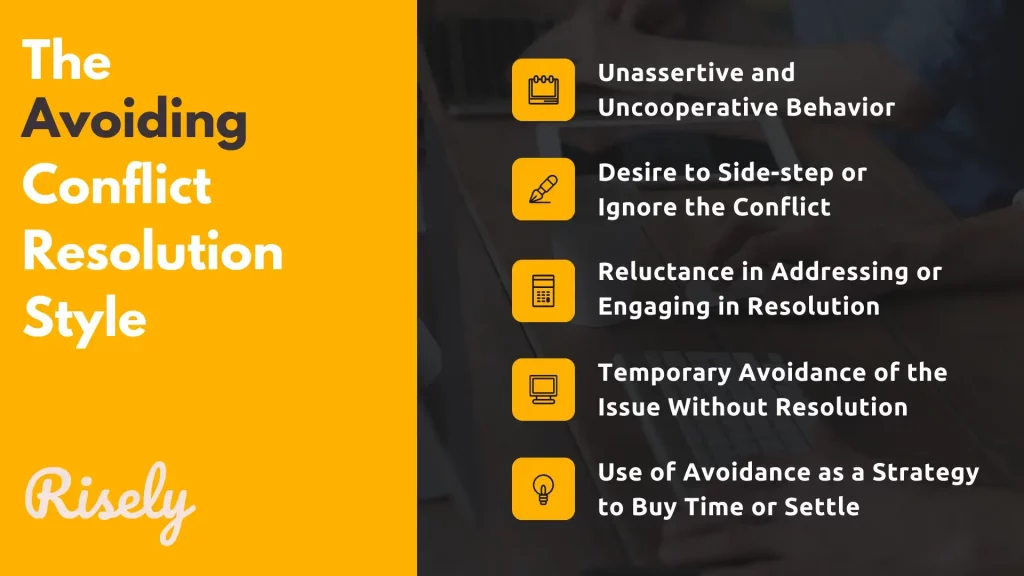
Collaborating
The “problem-solving” conflict resolution style has high assertiveness and cooperativeness. In this style, individuals work together with the other party to find a solution that meets the needs and concerns of all parties involved. This style is helpful when a person perceives that the issue at hand is essential and that the involved parties can find a mutually beneficial solution. Example of the collaborating style of conflict resolution: When a complex problem arises within the team, the manager brings together all involved team members for a brainstorming session. They encourage open communication and active participation from everyone to find a solution that takes into consideration the diverse perspectives and expertise of the team members. Advantages of the collaborating style:- It leads to a mutually beneficial solution that addresses the needs and concerns of all parties involved.
- It can improve relationships by creating a sense of teamwork and cooperation.
- It can be effective in resolving complex or long-term conflicts.
- It can be time-consuming and may not be feasible in situations where time is of the essence.
- It may be difficult to achieve if one or more parties are unwilling to cooperate.
- It may not be appropriate when one party has more power or resources than the other.
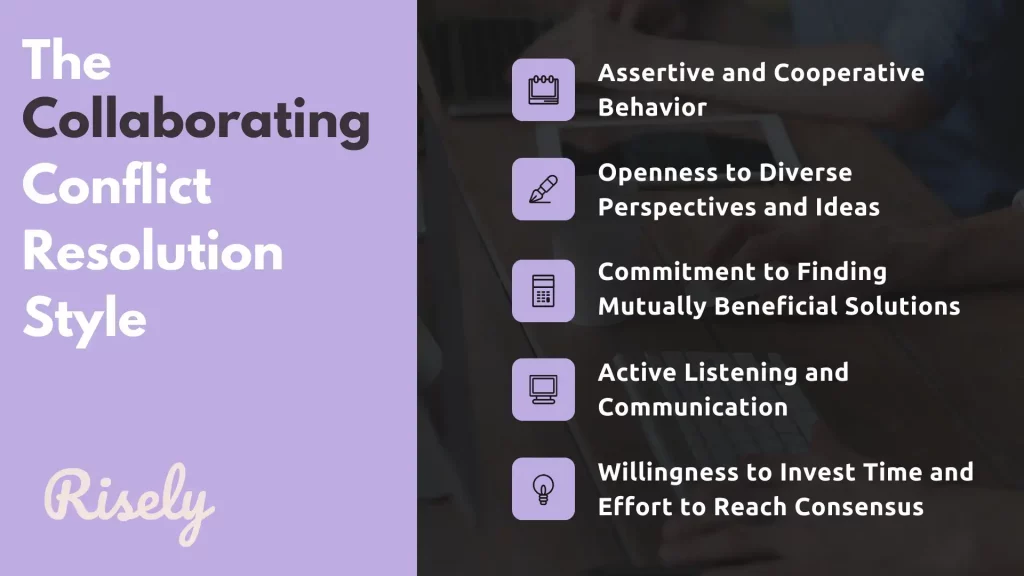
Compromising
The “compromising” conflict resolution style has moderate assertiveness and cooperativeness. In this style, individuals seek to find a middle ground and make concessions to reach an acceptable resolution for all parties involved, even if it is not the best solution for anyone. This conflict resolution style is often valid when a person perceives that a resolution needs to happen quickly and that a mutually beneficial solution is unlikely to be found. Example of the compromising style of conflict resolution: Two team members have differing opinions on how to allocate resources for an upcoming project. The manager facilitates a discussion where both team members are encouraged to share their viewpoints. The manager then proposes a solution that involves a middle-ground allocation of resources, which requires both team members to make some concessions. Advantages of the compromising style:- It can lead to a quick resolution of the conflict.
- It can be effective when both parties are willing to make concessions.
- It can help preserve relationships by avoiding prolonged conflict.
- It may not lead to a fair or mutually beneficial solution.
- It can result in one or more parties feeling unsatisfied with the outcome.
- It can be taken advantage of by the other party in future conflicts.
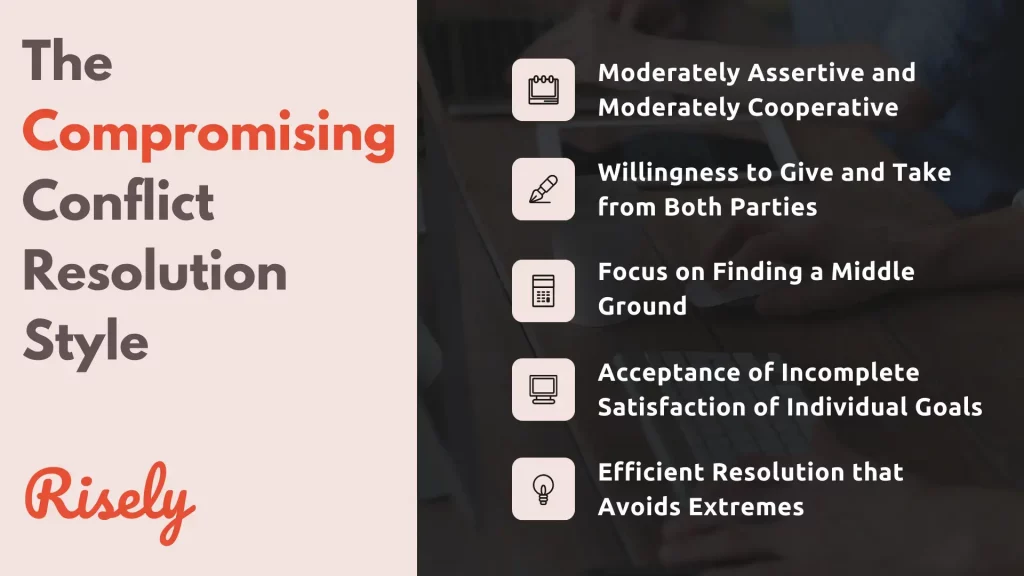
Other Interesting Reads
Tips for using the Conflict Management Style Grid
Here are some tips for using the conflict management styles grid:- Understand that different conflict resolution styles may be appropriate in different situations: Each style has its advantages and disadvantages, and the most effective managers can adapt their style depending on the specific circumstances of the conflict.
- Assess the situation: Before choosing a conflict resolution style, it’s vital to assess the nature of the conflict, the underlying causes, the interests and needs of all parties involved, the power dynamics at play, and the desired outcome.
- Communicate effectively: Effective communication is vital in conflict resolution. Listen actively and try to understand the other party’s perspective. Your communication style impacts the team heavily.
- Keep in mind the long-term goal: The goal of conflict resolution is not to “win” but to find a mutually beneficial solution that addresses the needs and concerns of all parties involved.
- Be prepared to use multiple styles: There may need more than one style to resolve a complex or long-term conflict. Therefore, be ready to use various styles in different stages of the conflict resolution process.
- Be aware of your biases: Our biases can affect our perspective on a conflict; be mindful and approach the situation objectively.
- Be open to feedback: Be open to input from the other party and be willing to adjust your approach if necessary.
- Seek support: If the conflict is complicated to resolve, seek the help of a neutral third party, such as a mediator, to facilitate the resolution process.
Conclusion
In conclusion, effective conflict resolution is essential for managers and leaders in any organization. The conflict resolution style grid discussed in the blog is valuable for identifying the most appropriate approach to resolving a conflict. Each style has its advantages and disadvantages, and the most effective managers can adapt their style depending on the specific circumstances of the conflict. It’s essential to understand the nature of the conflict, the underlying causes, the interests and needs of all parties involved, and the desired outcome. Effective communication, openness to feedback, and seeking support when necessary are crucial to resolving conflicts. Remember, the goal of using these conflict resolution styles is not to “win” but to find a mutually beneficial solution that addresses the needs and concerns of all parties involved.Are you keeping a tab on potential conflicts in your team?
Test your active listening skills today to make sure that you never let conflicts simmer
Conflict Resolution Styles FAQs
What are the 3 major roots of conflict?
The three major reasons for conflict in teams are differences in core values, unanswered concerns, and competition over limited resources.
What is the best type of conflict resolution?
Collaboration can be termed as the best conflict resolution strategy as it works with all the concerned stakeholders to arrive at mutually acceptable solutions.
What are the 3 Cs for resolving a conflict?
Effectively managing conflict needs you to balance the three Cs, namely
– Communication
– Conflict Resolution
– Commitment
– Communication
– Conflict Resolution
– Commitment
Other Related Blogs
Assertive Conflict Resolution Techniques | Brenda Hooper
Assertive Conflict Resolution Techniques | Brenda Hooper Can assertive communication help you out in resolving conflicts? In this podcast conversation, we have Brenda Hooper, an experienced executive coach joining us…
7 Conflict Resolution Scenarios At Work For Practice
7 Conflict Resolution Scenarios At Work For Practice Conflict resolution is one of the most important people management skills you must master. If conflicts on your team go unresolved, you…
Conflict Coach 101: A Beginner’s Guide
Conflict Coach 101: A Beginner’s Guide Did you know? Since 2008, we have doubled the hours we spend in conflicts at work. Research by the Myers-Briggs Company suggests that an…
5 Secrets To Conflict Resolution At Work For Managers
5 Secrets To Conflict Resolution At Work For Managers Conflict is all too common. We often encounter this ever-present demon in our workplaces, too. The trouble is manifold for managers…

